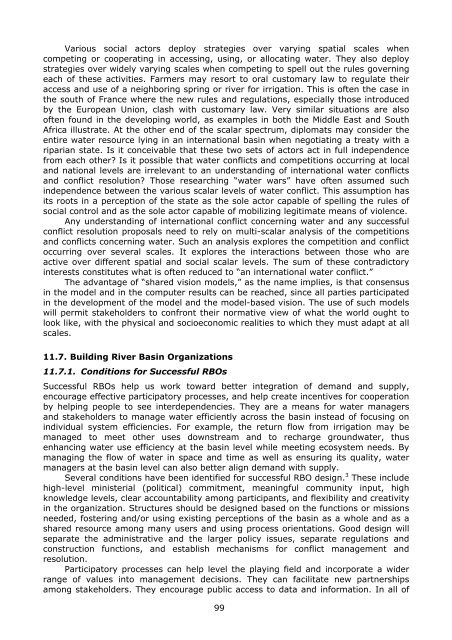Water security and peace: a synthesis of studies ... - unesdoc - Unesco
Water security and peace: a synthesis of studies ... - unesdoc - Unesco
Water security and peace: a synthesis of studies ... - unesdoc - Unesco
Create successful ePaper yourself
Turn your PDF publications into a flip-book with our unique Google optimized e-Paper software.
Various social actors deploy strategies over varying spatial scales when<br />
competing or cooperating in accessing, using, or allocating water. They also deploy<br />
strategies over widely varying scales when competing to spell out the rules governing<br />
each <strong>of</strong> these activities. Farmers may resort to oral customary law to regulate their<br />
access <strong>and</strong> use <strong>of</strong> a neighboring spring or river for irrigation. This is <strong>of</strong>ten the case in<br />
the south <strong>of</strong> France where the new rules <strong>and</strong> regulations, especially those introduced<br />
by the European Union, clash with customary law. Very similar situations are also<br />
<strong>of</strong>ten found in the developing world, as examples in both the Middle East <strong>and</strong> South<br />
Africa illustrate. At the other end <strong>of</strong> the scalar spectrum, diplomats may consider the<br />
entire water resource lying in an international basin when negotiating a treaty with a<br />
riparian state. Is it conceivable that these two sets <strong>of</strong> actors act in full independence<br />
from each other? Is it possible that water conflicts <strong>and</strong> competitions occurring at local<br />
<strong>and</strong> national levels are irrelevant to an underst<strong>and</strong>ing <strong>of</strong> international water conflicts<br />
<strong>and</strong> conflict resolution? Those researching “water wars” have <strong>of</strong>ten assumed such<br />
independence between the various scalar levels <strong>of</strong> water conflict. This assumption has<br />
its roots in a perception <strong>of</strong> the state as the sole actor capable <strong>of</strong> spelling the rules <strong>of</strong><br />
social control <strong>and</strong> as the sole actor capable <strong>of</strong> mobilizing legitimate means <strong>of</strong> violence.<br />
Any underst<strong>and</strong>ing <strong>of</strong> international conflict concerning water <strong>and</strong> any successful<br />
conflict resolution proposals need to rely on multi-scalar analysis <strong>of</strong> the competitions<br />
<strong>and</strong> conflicts concerning water. Such an analysis explores the competition <strong>and</strong> conflict<br />
occurring over several scales. It explores the interactions between those who are<br />
active over different spatial <strong>and</strong> social scalar levels. The sum <strong>of</strong> these contradictory<br />
interests constitutes what is <strong>of</strong>ten reduced to “an international water conflict.”<br />
The advantage <strong>of</strong> “shared vision models,” as the name implies, is that consensus<br />
in the model <strong>and</strong> in the computer results can be reached, since all parties participated<br />
in the development <strong>of</strong> the model <strong>and</strong> the model-based vision. The use <strong>of</strong> such models<br />
will permit stakeholders to confront their normative view <strong>of</strong> what the world ought to<br />
look like, with the physical <strong>and</strong> socioeconomic realities to which they must adapt at all<br />
scales.<br />
11.7. Building River Basin Organizations<br />
11.7.1. Conditions for Successful RBOs<br />
Successful RBOs help us work toward better integration <strong>of</strong> dem<strong>and</strong> <strong>and</strong> supply,<br />
encourage effective participatory processes, <strong>and</strong> help create incentives for cooperation<br />
by helping people to see interdependencies. They are a means for water managers<br />
<strong>and</strong> stakeholders to manage water efficiently across the basin instead <strong>of</strong> focusing on<br />
individual system efficiencies. For example, the return flow from irrigation may be<br />
managed to meet other uses downstream <strong>and</strong> to recharge groundwater, thus<br />
enhancing water use efficiency at the basin level while meeting ecosystem needs. By<br />
managing the flow <strong>of</strong> water in space <strong>and</strong> time as well as ensuring its quality, water<br />
managers at the basin level can also better align dem<strong>and</strong> with supply.<br />
Several conditions have been identified for successful RBO design. 3 These include<br />
high-level ministerial (political) commitment, meaningful community input, high<br />
knowledge levels, clear accountability among participants, <strong>and</strong> flexibility <strong>and</strong> creativity<br />
in the organization. Structures should be designed based on the functions or missions<br />
needed, fostering <strong>and</strong>/or using existing perceptions <strong>of</strong> the basin as a whole <strong>and</strong> as a<br />
shared resource among many users <strong>and</strong> using process orientations. Good design will<br />
separate the administrative <strong>and</strong> the larger policy issues, separate regulations <strong>and</strong><br />
construction functions, <strong>and</strong> establish mechanisms for conflict management <strong>and</strong><br />
resolution.<br />
Participatory processes can help level the playing field <strong>and</strong> incorporate a wider<br />
range <strong>of</strong> values into management decisions. They can facilitate new partnerships<br />
among stakeholders. They encourage public access to data <strong>and</strong> information. In all <strong>of</strong><br />
99
















